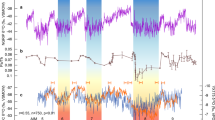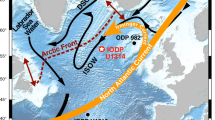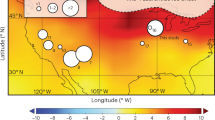Abstract
During the last glacial period, iceberg discharges into the North Atlantic disrupted the meridional overturning circulation, leading to cooling in the Northern Hemisphere and warming in Antarctica1,2. This asymmetric response can be explained by a bipolar see-saw mechanism3,4,5, whereby changes in the strength of the meridional overturning circulation lead to changes in the interhemispheric heat transport. It is unclear, however, to what extent the response of the overturning circulation is a function of freshwater flux and boundary climate conditions4. Here we use foraminiferal isotope and pollen records from the Portuguese margin to reconstruct surface- and deep-water hydrography and atmospheric changes during the last and penultimate glacial periods. When we compare our records with temperature reconstructions from Antarctica6, we find that the bipolar see-saw was a characteristic feature of both glacial periods. However, the comparison also underlines the dependence of the bipolar see-saw on background climate and magnitude of iceberg discharge. It also suggests that an intensified hydrological cycle may lead to a weaker overturning circulation with a smaller disruption threshold and extended North Atlantic stadial durations.
This is a preview of subscription content, access via your institution
Access options
Subscribe to this journal
Receive 12 print issues and online access
$259.00 per year
only $21.58 per issue
Buy this article
- Purchase on Springer Link
- Instant access to full article PDF
Prices may be subject to local taxes which are calculated during checkout




Similar content being viewed by others
References
Hemming, S. R. Heinrich events: Massive late Pleistocene detritus layers of the North Atlantic and their global climate imprint. Rev. Geophys. 42, 1–43 (2004).
Blunier, T. et al. Asynchrony of Antarctic and Greenland climate change during the last glacial period. Nature 394, 739–743 (1998).
Stocker, T. F. & Johnsen, S. J. A minimum thermodynamic model for the bipolar seesaw. Paleoceanography 18, PA1087 (2003).
Ganopolski, A. & Rahmstorf, S. Rapid changes of glacial climate simulated in a coupled climate model. Nature 409, 153–158 (2001).
Schmittner, A. & Galbraith, E. Glacial greenhouse-gas fluctuations controlled by ocean circulation changes. Nature 456, 373–376 (2008).
Jouzel, J. et al. Orbital and millennial Antarctic variability over the past 800,000 years. Science 317, 793–796 (2007).
McManus, J. F., Oppo, D. W. & Cullen, J. L. A 0.5-million-year record of millennial-scale climate variability in the North Atlantic. Science 283, 971–975 (1999).
Martrat, B. et al. Four climatic cycles of recurring deep and surface water destabilizations on the Iberian Margin. Science 317, 502–507 (2007).
Hodell, D. A., Channell, J. E. T., Curtis, J. H., Romero, O. E. & Röhl, U. Onset of ‘Hudson Strait’ Heinrich events in the eastern North Atlantic at the end of the middle Pleistocene transition (∼640 ka)? Paleoceanography 23, PA4218 (2008).
Ehlers, J. & Gibbard, P. L. (eds) in Quaternary Glaciations — Extent and Chronology (Elsevier, 2004).
van Kreveld, S. A., Knappertsbusch, M., Ottens, J., Ganssen, G. M. & van Hinte, J. E. Biogenic carbonate and ice-rafted debris (Heinrich layer) accumulation in deep-sea sediments from a Northeast Atlantic piston core. Mar. Geol. 131, 21–46 (1996).
Hiscott, R. N., Aksu, A. E., Mudie, P. J. & Parsons, D. F. A 340,000 year record of ice rafting, palaeoclimatic fluctuations, and shelf-crossing glacial advances in the southwestern Labrador Sea. Glob. Planet. Change 28, 227–240 (2001).
de Abreu, L., Shackleton, N. J., Schönfeld, J., Hall, M. & Chapman, M. Millennial-scale oceanic climate variability off the Western Iberian margin during the last two glacial periods. Mar. Geol. 196, 1–20 (2003).
Shackleton, N. J., Hall, M. A. & Vincent, E. Phase relationships between millennial-scale events 64,000–24,000 yr ago. Paleoceanography 15, 565–569 (2000).
EPICA community members. One-to-one coupling of glacial variability in Greenland and Antarctica. Nature 444, 195–198 (2006).
Skinner, L. C., Elderfield, H. & Hall, M. in Past and Future Changes of the Ocean’s Meridional Overturning Circulation: Mechanisms and Impacts (eds Schmittner, A., Chiang, J. & Hemming, S. R.) 197–208 (AGU Monograph, 2007).
Sánchez Goñi, M. F., Turon, J.-L., Eynaud, F. & Gendreau, S. European climatic response to millennial-scale changes in the atmosphere-ocean system during the last glacial period. Quat. Res. 54, 394–403 (2000).
Bard, E., Antonioli, F. & Silenzi, S. Sea-level during the penultimate interglacial period based on a submerged stalagmite from Argentarola Cave (Italy). Earth Planet. Sci. Lett. 196, 135–146 (2002).
Ayalon, A., Bar-Matthews, M. & Kaufman, A. Climatic conditions during marine oxygen isotope stage 6 in the eastern Mediterranean region from the isotopic composition of speleothems of Soreq Cave, Israel. Geology 30, 303–306 (2002).
Wang, Y. et al. Millennial- and orbital-scale changes in the East Asian monsoon over the past 224,000 yr. Nature 451, 1090–1093 (2008).
Mélières, M.-A., Rosignol-Strick, M. & Malaizé, B. Relation between low latitude insolation and δ18O change of atmospheric oxygen for the last 200 kyrs, as revealed by Mediterranean sapropels. Geophys. Res. Lett. 24, 1235–1238 (1997).
Malaizé, B. et al. Phase lag between intertropical convergence zone migration and subtropical monsoon onset over the northwestern Indian Ocean during Marine Isotope Substage 6.5 (MIS 6.5). Geochem. Geophys. Geosyst. 7, 1–16 (2006).
Tzedakis, P. C. Seven ambiguities in the Mediterranean palaeoenvironmental narrative. Quat. Sci. Rev. 26, 2042–2066 (2007).
Curry, W. B. in The South Atlantic: Present and Past Circulation (eds Wefer, G., Berger, W. H., Siedler, G. & Webb, D. J.) 577–598 (Springer, 1996).
Rashid, H., Hesse, R. & Piper, D. J. W. Evidence for an additional Heinrich event between H5 and H6 in the Labrador Sea. Paleoceanography 18, PA1077 (2003).
Vautravers, M. & Shackleton, N. J. Centennial scale surface hydrology off Portugal during Marine Isotope Stage 3: Insights from planktonic foraminiferal fauna variability. Paleoceanography 21, PA3004 (2006).
NGRIP Ice Core Project Members. High-resolution record of Northern Hemisphere climate extending into the last interglacial period. Nature 431, 147–151 (2004).
Svensson, A. et al. A 60,000 year Greenland stratigraphic ice core chronology. Clim. Past 4, 47–57 (2008).
Siddall, M. et al. Sea-level fluctuations during the last glacial cycle. Nature 423, 853–858 (2003).
Waelbroeck, C. et al. Sea-level and deep water temperature changes derived from benthic foraminifera isotopic records. Quat. Sci. Rev. 21, 295–305 (2002).
Acknowledgements
We remain overwhelmed by the loss of N.J.S., who provided the inspiration for this project. We thank J. McManus, L. de Abreu, B. Martrat and J. Grimalt for discussions and published data, and J. Corr, M. Hall and V. Rennie for technical support. Financial support was provided by NERC (NE/C514758/1), EU (EV K2-CT-2000-00089) and the Royal Society.
Author information
Authors and Affiliations
Contributions
N.J.S. initiated the project and generated the benthic isotope record. M.V. generated planktonic isotope data. A.G. provided model simulations and conceptual advice. P.C.T. supervised the project. L.C.S. generated extra planktonic and benthic isotope data. V.M. generated the pollen record. V.M., L.C.S., A.G. and P.C.T. wrote the paper. All authors contributed to the interpretation of the results.
Corresponding authors
Ethics declarations
Competing interests
The authors declare no competing financial interests.
Supplementary information
Supplementary Information
Supplementary Information (PDF 844 kb)
Rights and permissions
About this article
Cite this article
Margari, V., Skinner, L., Tzedakis, P. et al. The nature of millennial-scale climate variability during the past two glacial periods. Nature Geosci 3, 127–131 (2010). https://doi.org/10.1038/ngeo740
Received:
Accepted:
Published:
Issue Date:
DOI: https://doi.org/10.1038/ngeo740
This article is cited by
-
Dansgaard-Oeschger cycles of the penultimate and last glacial period recorded in stalagmites from Türkiye
Nature Communications (2024)
-
Millennial-scale climate variability in the Northern Hemisphere influenced glacier dynamics in the Alps around 250,000 years ago
Communications Earth & Environment (2023)
-
Iberian Margin surface ocean cooling led freshening during Marine Isotope Stage 6 abrupt cooling events
Nature Communications (2023)
-
Dietary traits of the ungulates from the Middle Pleistocene sequence of Lazaret Cave: palaeoecological and archaeological implications
Archaeological and Anthropological Sciences (2023)
-
Asian monsoon intensity coupled to Antarctic climate during Dansgaard–Oeschger 8 and Heinrich 4 glacial intervals
Communications Earth & Environment (2022)



